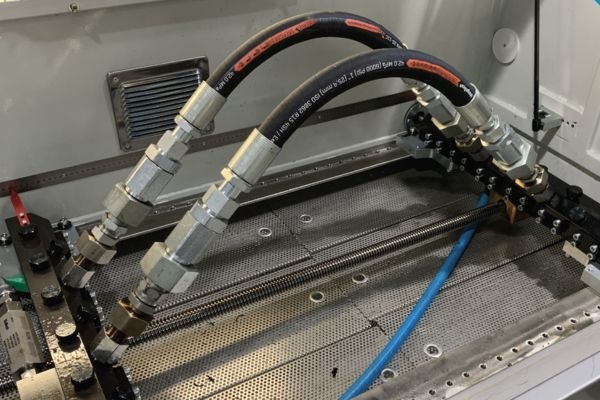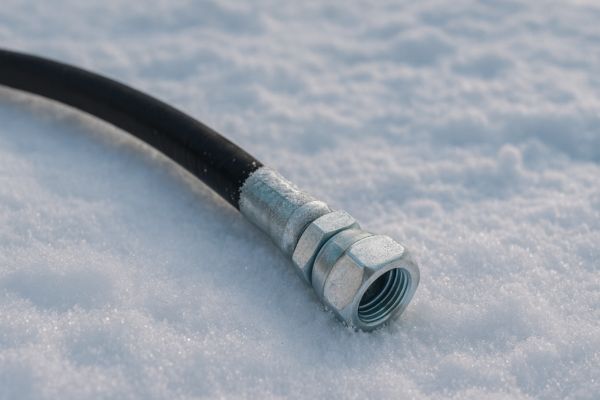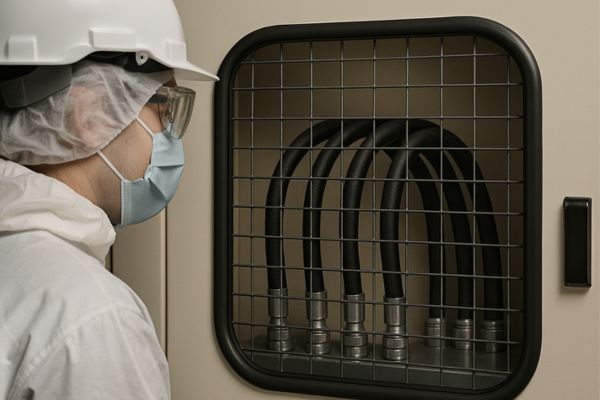You trust a hydraulic hose with thousands of PSI. A sudden failure means dangerous, high-pressure leaks, costly downtime, and serious safety risks for your entire team.
To prevent this, every reputable hose is subjected to brutal tests defined by SAE and ISO standards. These tests, from burst to impulse, prove the hose can handle pressure, temperature, and flexing, guaranteeing its safety and reliability.
How Do We Verify a Hose’s True Strength?
The hose is rated for 3,000 PSI, but can you trust it? A pressure spike could cause a catastrophic burst, destroying equipment and endangering personnel nearby. This uncertainty is a major risk.
We confirm its strength with a destructive Burst Test. A new hose assembly is pressurized evenly until it fails. This failure point must be at least four times its maximum working pressure, proving it meets the industry-standard 4:1 safety factor.

The burst test is the most dramatic and fundamental proof of quality. It’s not about finding the average strength; it’s about confirming the minimum strength. This safety margin is designed to handle the unexpected pressure surges that occur in real-world hydraulic systems. It ensures that even under stress, the hose has a deep reserve of strength, giving you a critical layer of protection against a sudden, violent failure.
The Burst Test Procedure
The method is simple and severe. We take a brand new hose assembly, typically one that has been crimped for less than 30 days. It is attached to a hydraulic test stand within a secure, armored chamber. The pressure inside the hose is then increased at a slow, steady rate until the hose fails. The pressure reading at the moment of failure is recorded as its actual burst pressure.
What Defines an Official Failure?
A “fail” isn’t just a dramatic explosion. Any of the following events occurring below the specified minimum burst pressure (4x the working pressure) means the hose is rejected:
- Any visible leak from the hose or fittings.
- The formation of a significant bulge or bubble on the hose cover.
- The hose fitting being ejected from the end of the hose.
- The hose itself rupturing or bursting.
Why the 4:1 Safety Factor is Non-Negotiable
This safety factor is the core of hydraulic safety. A hose rated for 4,000 PSI working pressure must not burst below 16,000 PSI. This buffer is not extra capacity for you to use. It’s there to absorb the energy from system shocks, like a valve closing suddenly or a cylinder hitting the end of its stroke. This design principle ensures that normal system dynamics do not push the hose past its true physical limits.
Will the Hose Work in Extreme Cold?
It’s freezing outside. A normal hose can become as brittle as glass. When it flexes, it can crack instantly, causing a massive and dangerous fluid spill and stopping your operation cold.
A hose is “soaked” at its lowest rated temperature (e.g., -40°C) for 24 hours. It is then bent around a mandrel. Afterward, it must pass a pressure test with no cracks or leaks.

Rubber and plastic properties change dramatically with temperature. A hose that is flexible at room temperature can become stiff and fragile in the cold. This test is crucial for equipment used in cold climates or refrigeration applications. It proves that the hose’s material compound is engineered to remain ductile and reliable, even when the temperature plummets.
The 24-Hour Cold Soak
The procedure begins by placing a straight sample of the hose assembly into a specialized low-temperature chamber. The chamber is held at the hose’s minimum rated operating temperature for a full 24 hours. This ensures the entire hose, from the outer cover to the inner tube, is thoroughly saturated at the target cold temperature.
The Critical Mandrel Bend
After 24 hours in the cold, while still inside the chamber, the hose is immediately bent 180 degrees around a metal cylinder, called a mandrel. The diameter of this mandrel is based on the hose’s specified minimum bend radius. Any loss of flexibility will be revealed instantly, as a brittle material will not withstand this bend. The hose is visually inspected for any signs of cracks, splits, or fractures in the cover or inner tube.
The Final Proof: Pressure Hold
After the bend test, the hose is allowed to return to room temperature. It is then subjected to a proof pressure test, typically at twice its maximum working pressure. This final step confirms that the cold bending did not cause any microscopic damage that could lead to a leak under pressure. The hose must hold this pressure without any leakage to pass the test.
Can It Survive a Lifetime of Pressure Spikes?
Your machine’s hydraulic system is constantly pulsing with pressure. These millions of cycles fatigue the hose’s wire reinforcement, leading to a sudden, unexpected failure long before the hose looks worn out.
This is why we perform an Impulse Test. A bent hose assembly is subjected to hundreds of thousands—or even millions—of rapid pressure cycles, often at high temperatures. This simulates a lifetime of heavy use to prove its durability and fatigue resistance.

The impulse test is a true test of endurance. It’s probably the most important test for predicting the service life of a hose in a dynamic application. A hose can easily handle a single pressure load, but can it handle that same load a million times? This test separates well-engineered hoses from inferior ones. It proves the quality of the wire reinforcement and the integrity of the crimp, ensuring the assembly won’t fail from metal fatigue halfway through its expected life.
The Impulse Test Method
The standard impulse test follows a precise protocol:
- The hose assembly is bent, often to 90° or 180°, and installed on the test stand.
- Hot hydraulic fluid (usually around 100°C) is circulated through the hose.
- The pressure is rapidly cycled from near zero up to 100% to 133% of the hose’s maximum working pressure.
- This cycle is repeated at a frequency of about once per second.
The test continues until the hose completes the number of cycles required by the standard (e.g., 200,000 cycles for a standard 2SN hose). Some high-performance hoses are tested for millions of cycles.
The “Flex-Impulse” Upgrade
For an even more severe test, we use a Flex-Impulse machine. In this setup, one end of the hose assembly is fixed, while the other is mounted on a moving carriage. As the hose is being impulse tested, the carriage moves back and forth, forcing the hose to flex and bend continuously. This simulates the demanding reality of an excavator arm or a piece of mobile equipment, testing both fatigue and flexibility at the same time.
How Well Does the Hose Resist Abrasion?
Hoses often rub against machine frames, brackets, or even each other. This constant friction can wear through the outer cover, exposing the steel reinforcement to rust and damage, leading to a premature and hidden failure.
We measure this durability with an Abrasion Test. A specialized machine rubs an abrasive surface back and forth across the hose cover under a set load. The test measures how many cycles it takes to wear through the cover and expose the wire braid.
The outer cover is a hose’s first line of defense against the outside world. Its ability to resist abrasion is critical for a long service life, especially in tight or moving applications. This test allows us to quantify that durability. It is the difference between a standard cover and a premium “tough cover,” which can be engineered to be hundreds of times more resistant to abrasion.
The Abrasion Test Mechanism
The test is defined by standards like ISO 6945. A sample of the hose is mounted on the machine. A steel platen with a specific weight is placed on top of it. This platen, which may be a screen or a bar, then oscillates back and forth along the length of the hose. A counter tracks the number of cycles. The test is stopped periodically to inspect the hose.
How a “Pass” or “Fail” is Determined
The test ends when the steel wire reinforcement becomes visible. The number of cycles completed at that point is the hose’s abrasion rating. This quantitative result allows for direct comparison between different hose covers. A standard cover might fail after 20,000 cycles, while a high-performance cover from our factory might endure over 1,000,000 cycles under the same conditions. This proves its superior durability for demanding environments.
How Do We Ensure Dimensional Accuracy?
You order a hose assembly, but when it arrives, it’s slightly too long or the fitting is crooked. Even small inaccuracies can make installation impossible or create stress points that lead to failure.
We prevent this with rigorous Change-in-Length and dimensional checks. We measure the hose’s length before and during pressurization to ensure it doesn’t change excessively. All fitting angles and lengths are checked with precision gauges against strict tolerances.

A hose is not a static component. When pressurized, it will naturally try to contract in length and expand in diameter. A well-designed hose minimizes this change. Excessive changes in length can pull on fittings and cause stress. This test, along with precise initial measurements, ensures that the hose you receive is not only the correct length out of the box but also behaves predictably and reliably once it’s installed and put to work in your system.
Measuring Change Under Pressure
The “Change-in-Length” test is straightforward. A precise length of hose is measured at atmospheric pressure. It is then pressurized to its maximum working pressure and held there for a short period. The length is measured again while under pressure. According to ISO and SAE standards, the hose’s length cannot change by more than a small percentage (typically between -4% and +2%). This proves the stability of its construction.
Verifying Length and Angle Tolerances
Before shipping, every assembly is checked against the customer’s order.
- Length: We measure the overall length from the specified sealing surfaces using calibrated tools. The length must fall within the tight tolerances defined by the standard.
- Angle: For assemblies with two bent ends, the relative angle (the “V-angle”) is placed on a fixture and measured. It must match the specified orientation (e.g., V90, V180) to ensure a twist-free installation.
Conclusion
These brutal tests are our promise of quality. They ensure that every hose leaving our factory is proven to be safe, durable, and reliable, ready to perform under the toughest conditions you can throw at it.
Topa hydraulic hoses are engineered to handle high pressure, extreme conditions, and demanding applications with confidence. Built to international SAE and EN standards, our hoses deliver reliable performance, long service life, and proven safety. Contact us today to place your order and keep your equipment operating without interruption.
FAQ
Why do hydraulic hoses need to be tested?
Testing ensures the hose can handle pressure, temperature, and flexing safely before being used in real systems.
What is a burst test?
A burst test pressurizes a hose until it fails, confirming it meets the 4:1 safety factor required by standards.
How do you test hoses for cold weather use?
The hose is frozen for 24 hours at its minimum temperature, bent around a mandrel, and then pressure-tested for cracks or leaks.
What is an impulse test?
An impulse test cycles the hose through hundreds of thousands of pressure spikes to simulate years of use and prove durability.
How do you check abrasion resistance?
A machine rubs the hose cover until the reinforcement is exposed, measuring how many cycles it can withstand.
Why check dimensional accuracy?
Precise length and angle checks ensure the hose installs correctly and won’t be stressed or twisted under pressure.





